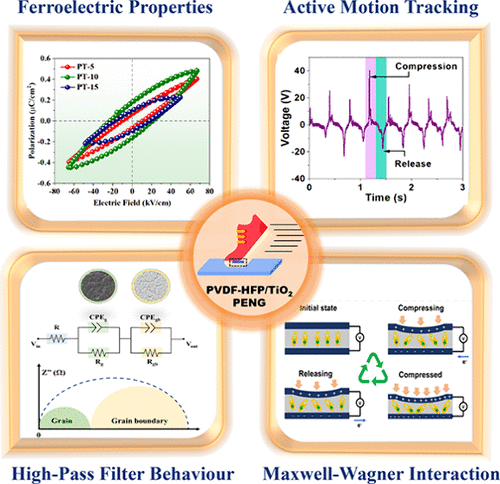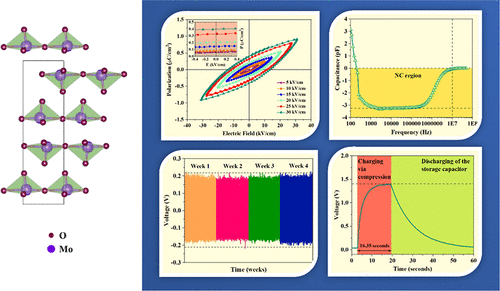Smart Energy Materials and Systems Lab


Piezoelectricity
Piezoelectricity is the phenomenon in which electric charges accumulate in certain materials in response to applied mechanical stress. In our lab, we are working on high- as well as low-temperature piezoelectric materials for energy harvesting and sensing applications.
Research Publications
Some of the highlighted research publications

ACS Appl. Mater. Interfaces 2023, 15, 39, 45812–45822
A significant driving force for the fabrication of IoT-compatible smart health gear integrated with multifunctional sensors is the growing trend in fitness and the overall wellness of the human body. In this work, we present an autonomous motion and activity-sensing device based on the efficacious nucleation of the polar β-phase in an electroactive polymer. Representatively, we investigate the nucleating effect of TiO2 nanoparticles on weight-modulated PVDF-HFP films (PT-5, PT-10, and PT-15) and subsequently prototype a sensing device with the film that demonstrates superior β-phase nucleation. The PT-10 film, with an optimal polar β-phase, shows the highest remnant polarization (2Pr) and energy density of 0.36 μC/cm2 and 22.3 mJ/cm3, respectively, at 60 kV/cm. The films mimic a high pass filter at frequencies above 10 KHz with very low impedance and high ac conductivity values. The frequency-dependent impedance studies reveal an effective interfacial polarization between TiO2 nanoparticles and PVDF-HFP, explicitly observed in the low-frequency region. Consequently, the sensor fabricated with PT-10 as the sensing layer exhibits ultralow frequency detection (25 Hz) resulting from the blood flow muscle oxygenation. The device successfully senses voluntary joint movements of the human body and actively tracks a range of motions, from brisk walking to running. Additionally, through repetitive human finger-tapping motion, the nanogenerator lights up multiple light-emitting diodes in series and charges capacitors of varying magnitudes under 50 s. The real-time human motion sensing and movement tracking modalities of the sensor hold promise in the arena of smart wearables, sports biomechanics, and contact-based medical devices.

ACS Appl. Electron. Mater. 2023, 5, 6, 3130–3143
Driven by the notion that the spectrum of ferroelectric applications can be widened and the current subset of materials could be replaced with earth-abundant, lead-free materials, single-phase α-MoO3 (MO) with biaxial van der Waals gap was synthesized, revealing an orthorhombic Pmcn symmetry with a layered ABAB... sequence, with mirrored A and B layers. The force-driven dielectric constant of MO was found to be 12.5 at 0.5 N force level, which showed dielectric saturation behavior with increasing dynamic force. Ferroelectric studies revealed a maximum of 46% efficiency at 10 kV/cm external electric field, and piezoelectric modulus (d33) of 30 pC/N was obtained using the Berlincourt method. Negative capacitance (NC) effects were observed and attributed to the ferroelectric-induced emf and the inductive reactance, in accordance with Lenz’s law. Based on the confluence of the aforementioned features, a piezoelectric energy harvester (PEH) was fabricated, which reached a peak voltage of 4 V under repetitive finger tapping. The power density of the PEH under 100 MΩ resistive load was found to be 7.32 × 10–1 μW/cm2. This enshrines MO as a promising piezoelectric candidate with exotic properties that can be tailored to have multifaceted applications in the realm of sensing and energy harvesting to drive Internet-of-Things and Industry 4.0.

Mater. Res. Bull. 157, 112038
We have comprehensively investigated the structural, morphological, vibrational, thermal, and surface charge properties of ZnTa2O6 (ZTO) system, which is predicted to be a novel, lead-free, high-temperature piezoelectric candidate. Single-phase polycrystalline samples were formed having orthorhombic Pbcn symmetry with the tri-α-PbO2 structure. ZTO was highly Raman active, expressing higher electronically excited states of even parity and with the presence of far-IR modes. The crystallization of ZTO was observed at ∼691 °C with a melting enthalpy, ∆Hm = ∼301.7 J/g. Force-driven dielectric constant (εr) was found to be 7.05 with an ultra-low loss tangent value of 1 × 10−4 at 0.45 N dynamic force. Energy storage efficiency of 43% at 5 kV/cm and a piezoelectric charge coefficient (d33) value of 20 pC/N were obtained. The confluence of all these properties makes ZTO a novel piezoelectric material with high-temperature stability whilst further evoking applications in energy harvesting, electronics, memory storage, and electromechanical systems.